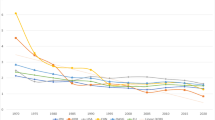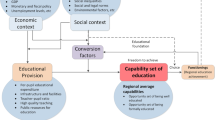Abstract
How geographical neighboring competitors influence the strategic recruiting behavior of universities is still unclear because previous studies assume spatial independence among universities. Using data of Subordinate Universities of the Ministry of Education in China, this study found that the choice of admission score level by one university was spatially autocorrelated with its neighboring competitors and four strategies came into being within spatial enrollment competition. The intenseness of spatial competition decreased as the number of neighboring competitors increased while the difference of admission score increased as the distance between competitive universities increased.



Similar content being viewed by others
References
Abbott, W. F., & Schmid, C. F. (1975). University prestige and first-time undergraduate migration in the united states. Sociology of Education, 48(2), 168–185.
Anselin, L. (1988). Spatial econometrics: Methods and models. Dordrecht: Kluwer Academic.
Anselin, L. (1996). The moran scatterplot as an esda tool to assess local instability in spatial association. In M. M. Fischer & H. J. Scholten (Eds.), Spatial analytical perspectives on gis (pp. 111–126). London: Taylor & Francis.
Babcock, L. C., Engberg, J. B., & Greenbaum, A. R. T. (2005). Wage spillovers in public sector contract negotiations: The importance of social comparisons. Regional Science and Urban Economics, 35(4), 395–416.
Baryla, E., & Dotterweich, D. (2004). Student migration: Do significant factors vary by region? Education Economics, 9(3), 269–280.
Bauer, P., & Riphahn, R. T. (2007). Heterogeneity in the intergenerational transmission of educational attainment: Evidence from switzerland on natives and second-generation immigrants. Journal of Population Economics, 20(1), 121–148.
Benirschka, M., & Binkley, J. K. (1994). Land price volatility in a geographically dispersed market. American Journal of Agricultural Economics, 76(2), 185–195.
Brueckner, J. K. (1998). Testing for strategic interaction among local governments: The case of growth controls. Journal of Urban Economics, 44(3), 438–467.
Cameron, K. (1983). Strategic responses to conditions of decline: Higher education and the private sector. The Journal of Higher Education, 54(4), 359–380.
Carlton, D., Bamberger, G., & Epstein, R. (1995). Antitrust and higher education: Was there a conspiracy to restrict financial aid? The Rand Journal of Economics, 26(1), 131–147.
Case, A., Hines, J., & Rosen, H. (1993). Budget spillovers and fiscal policy interdependence: Evidence from the states. Journal of Public Economics, 52(3), 285–307.
Chaffee, E. (1984). Successful strategic management in small private colleges. The Journal of Higher Education, 55(2), 212–241.
Chapman, D. (1981). A model of student college choice. The Journal of Higher Education, 52(5), 490–505.
Checchi, D. (2000). University education in italy. International Journal of Manpower, 21(3–4), 177–205.
Chesson, P. (2000). General theory of competitive coexistence in spatially-varying environments. Theoretical Population Biology, 58(3), 211–237.
China compendium of statistics 1949-2008 (2010). Beijing: China Statistics Press.
Connelly, R., & Zheng, Z. (2003). Determinants of school enrollment and completion of 10 to 18 year olds in china. Economics of Education Review, 22(4), 379–388.
Corrazzini, A., Dugan, D., & Grabowski, H. (1972). Determinants and distributional aspects of enrollment in U.S. Higher education. Journal of Human Resources, 7, 39–50.
Dolence, M. (1998). Strategic enrollment management (Handbook for the college admission profession). Washington, D.C: American Association of Collegiate Registrars and Admissions Officers.
Dongpoing, Y. (2005). China’s education in 2003: From growth to reform. Chinese Education & Society, 38(4), 11–45.
Figlio, D., Koplin, V., & Reid, W. (1999). Do states play welfare games? Journal of Urban Economics, 46(3), 437–454.
Frank, R. J. (2001). Higher education: The ultimate winner-take-all market. In M. Devlin & J. Meyerson (Eds.), Forum futures- exploring the future of higher education. San Francisco CA: Jossey- Bass.
Fredriksson, P. G., & Millimet, D. L. (2002a). Strategic interaction and the determination of environmental policy across u.S. States. Journal of Urban Economics, 51(1), 101–122.
Fredriksson, P. G., & Millimet, D. L. (2002b). Is there a “california effect” in us environmental policymaking? Regional Science and Urban Economics, 32(6), 737–764.
Getis, A., Mur, J., & Zoller, H. (2004). Spatial econometrics and spatial statistics. New Yord: Palgrave Macmillan.
Ghosh, S. (2010). Strategic interaction among public school districts: Evidence on spatial interdependence in school inputs. Economics of Education Review, 29(3), 440–450.
Gowen, J., & Owen, V. (2006). Enrollment management and strategic planning: Resolving a classic tension in higher education. Nonprofit Management and Leadership, 2(2), 143–158.
Greenbaum, R. T. (2002). A spatial study of teachers’ salaries in pennsylvania school districts. Journal of Labor Research, 23(1), 69–86.
Hannum, E. (1999). Political change and the urban-rural gap in basic education in china, 1949–1990. Comparative Education Review, 43(2), 193–211.
Hauert, C., & Doebeli, M. (2004). Spatial structure often inhibits the evolution of cooperation in the snowdrift game. Nature, 428(6983), 643–646.
Jalan, J., & Ravallion, M. (2002). Geographic poverty traps? A micro model of consumption growth in rural china. Journal of Applied Econometrics, 17(4), 329–346.
Kyung, W. (1996). In-migration of college students to the state of new york. Journal of Higher Education, 67(3), 349–358.
Law, W. (1995). The role of the state in higher education reform: Mainland china and taiwan. Comparative Education Review, 39(3), 322–355.
Leppel, K. (1993). Logit estimation of a gravity model of the college enrollment decision. Research in Higher Education, 34(3), 387–398.
LeSage, J., & Pace, R. (2009). Introduction to spatial econometrics. Florida: Chapman & Hall/CRC.
Maltz, E., Murphy, K., & Hand, M. (2007). Decision support for university enrollment management: Implementation and experience. Decision Support Systems, 44(1), 106–123.
Marginson, S. (2006). Dynamics of national and global competition in higher education. Higher Education, 52(1), 1–39.
Mause, K. (2009a). Too much competition in higher education? Some conceptual remarks on the excessive-signaling hypothesis. American Journal of Economics and Sociology, 68(5), 1107–1133.
Mause, K. (2009b). Too much competition in higher education? Some conceptual remarks on the excessive-signaling hypothesis. American Journal of Economics and Sociology, 68(5), 1107–1133.
McMillen, D., SINGELL, L., & Waddell, G. (2007). Spatial competition and the price of college. Economic Inquiry, 45(4), 817.
Millimet, D., & Rangaprasad, V. (2007a). Strategic competition amongst public schools. Regional Science and Urban Economics, 37(2), 199–219.
Millimet, D. L., & Rangaprasad, V. (2007b). Strategic competition amongst public schools. Regional Science and Urban Economics, 37(2), 199–219.
Mok, K. (2000). Marketizing higher education in post-mao china. International Journal of Educational Development, 20(2), 109–126.
Moran, P. A. P. (1950). Notes on continuous stochastic phenomena. Biometrika, 37, 17–33.
Paulsen, M., & Pogue, T. (1988). Higher education enrollment: The interaction of labor market conditions, curriculum, and selectivity. Economics of Education Review, 7(3), 275–290.
Qiping, Y., & White, G. (1994). The ‘marketisation’of chinese higher education: A critical assessment. Comparative Education, 30(3), 217–221.
Ready, K. J., & Sandver, M. H. (1993). Pattern bargaining in education. Education Economics, 1(3), 259–266.
Rong, X., & Shi, T. (2001). Inequality in chinese education. Journal of Contemporary China, 10(26), 107–124.
Rosen, S. (1985). Recentralization, decentralization, and rationalization: Deng xiaoping’s bifurcated educational policy. Modern China, 11(3), 301.
Rowse, G., & Wing, P. (1982). Assessing competitive structures in higher education. The Journal of Higher Education, 53, 656–686.
Saavedra, L. A. (2000). Amodel of welfare competition with evidence from afdc. Journal of Urban Economics, 47(2), 248–279.
Saint, W., Hartnett, T. A., & Strassner, E. (2003). Higher education in nigeria: A status report. Higher Education Policy, 16(3), 259–281.
Unger, J. (1980). The chinese controversy over higher education. Pacific Affairs, 53(1), 29–47.
Wagner, G. A., & Porter, T. S. (2000). Location effects and the determination of beginning teacher salaries: Evidence from ohio. Education Economics, 8(2), 109–127.
Winston, G. (1999). Subsidies, hierarchy and peers: The awkward economics of higher education. The Journal of Economic Perspectives, 13(1), 13–36.
Winston, G. (2004). Differentiation among us colleges and universities. Review of Industrial Organization, 24(4), 331–354.
Zammuto, R. F. (1985a). Geographic proximity and enrollment competition. Boulder: National Center for Higher Education Management Systems.
Zammuto, R. F. (1985b). Characteristics of enrollment competition in higher education. Boulder: National Center for Higher Education Management Systems.
Zemsky, R., Shaman, S., & Berberich, M. (1980). Toward an understanding of colle- giate enrollments: A first test of the market segment model. Journal of Education Finance, 5, 335–374.
Zwerling, H. L., & Thomason, T. (1995). Collective bargaining and the determinants of teachers’ salaries. Journal of Labor Research, 16(4), 467–484.
Acknowledgments
This research was supported by the MOE Project of Key Research Institute of Humanities and Social Sciences in Universities, Project 2009JJD880002. Special thanks go to W. Norton Grubb, Luc Anselin and Mun C. Tsang for general guidance and specific comments. We are grateful for comments and suggestions by Zeqi Qiu, Xiaohao Ding, Chongren Xu, Xiaodong Lu, two anonymous referees and the editor, Amy Scott Metcalfe. All remaining errors and omissions are my own.
Author information
Authors and Affiliations
Corresponding author
Rights and permissions
About this article
Cite this article
Gu, J. Spatial recruiting competition in Chinese higher education system. High Educ 63, 165–185 (2012). https://doi.org/10.1007/s10734-011-9429-8
Published:
Issue Date:
DOI: https://doi.org/10.1007/s10734-011-9429-8




